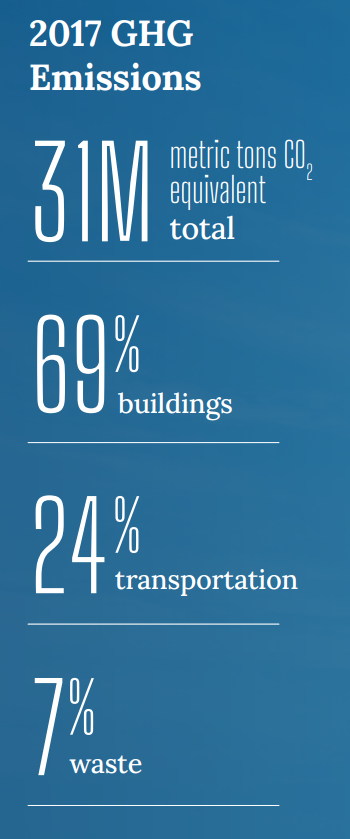Electrify Chicago
An independent tool for viewing City of Chicago building data
According to the
2022 Chicago Climate Action Plan,
69% of Chicago's emissions come from buildings, making
building emissions our biggest challenge and our biggest opportunity as a city
to tackle climate change. At Electrify Chicago, we showcase building performance using
publicly available data supplemented by community-submitted photographs and building
owners.
Start by looking at Chicago's buildings with the highest greenhouse gas intensity i.e. emissions per square foot. Large, efficient, buildings can perform much better than very inefficient small buildings on this metric.
New Article
📰 $30 Million In Missed Fines
The City Of Chicago failed to collect $30 million in potential fines from the building benchmarking ordinance, reducing transparency and accountability.
Legislative update! 🎉
As of late January 2024, legislation is being introduced to require new use more efficient forms of water and space heating, via the Clean And Affordable Buildings Ordinance (CABO), which will reduce the number of highly polluting and inefficient buildings that end up on this site.
If you're in Chicago,
write to your alderman to support the CABO!
Chicago Buildings by Greenhouse Gas Intensity
Note: Data includes large Chicago buildings with data from 2022, unless explicitly stated otherwise.
Note: This data only includes buildings whose emissions are reported
under the
Chicago Energy Benchmarking Ordinance. According to the City “As of 2016,
this list includes all commercial, institutional, and residential buildings larger than
50,000 square feet.” This dataset is also then filtered to only buildings with
reported emissions > 1,000 metric tons CO2 equivalent.
The latest year of data is from 2022, but we update the site regularly when new data is available, and some buildings may have failed to report that year, and only have older data available.
| Property Name / address | Primary Property Type |
Greenhouse Gas Intensity (kg CO2 eq./sqft) |
Total Greenhouse Emissions (metric tons CO2 eq.) |
|---|---|---|---|
|
Jewel Osco, 03176-Ashland & 95th St
9400 S Ashland Ave
| Supermarket/Grocery Store | 15.0 kg/sqft
Highest 5%
| 994 tons
Highest 45%
|
|
Cobbler Square Lofts
1350 N Wells St
| Multifamily Housing | 15.0 kg/sqft
Highest 5%
| 2,124 tons
Highest 21%
|
|
Sullivan Athletic Center
(DePaul)
2323 N Sheffield Ave
| College/University | 15.0 kg/sqft
Highest 5%
| 956 tons
Highest 47%
|
|
S1-Sinai
🚩
1525 S CALIFORNIA AVE
| Hospital (General Medical & Surgical) | 14.9 kg/sqft
Highest 5%
| 12,679 tons #44 Highest
|
|
The Racquet Club Chicago
1357 1367 N DEARBORN ST
| Fitness Center/Health Club/Gym | 14.9 kg/sqft
Highest 5%
| 925 tons
Highest 48%
|
|
150-160 E. Huron
🕰️
150-160 E. Huron
| Hotel | 14.9 kg/sqft | 5,343 tons |
|
Walmart Supercenter #5781
🕰️
8331 S Stewart Ave
| Wholesale Club/Supercenter | 14.8 kg/sqft | 2,190 tons |
|
Advocate Center
15 S Wood St
| Other | 14.8 kg/sqft
Highest 5%
| 886 tons
Lowest 50%
|
|
1440 S WABASH AVE
1440 S WABASH AVE
| Multifamily Housing | 14.8 kg/sqft
Highest 5%
| 922 tons
Highest 48%
|
|
65 E GOETHE ST
65 E GOETHE ST
| Multifamily Housing | 14.8 kg/sqft
Highest 5%
| 1,701 tons
Highest 27%
|
|
2013-Chicago Downtown - Franklin/Madison (RR ONLY)
🕰️
1 South Franklin Street
| Hotel | 14.7 kg/sqft | 2,065 tons |
|
House of Blues Chicago
329 N Dearborn St
| Performing Arts | 14.7 kg/sqft
Highest 5%
| 802 tons
Lowest 46%
|
|
Jeffery Plaza
2101 E 71ST ST
| Supermarket/Grocery Store | 14.7 kg/sqft
Highest 5%
| 1,661 tons
Highest 28%
|
|
Soldier Field
🕰️
1410 South Museum Campus Drive
| Stadium (Open) | 14.7 kg/sqft | 22,703 tons |
|
2535 S Dr Martin Luther King Jr Dr
2535 S Dr Martin Luther King Jr Dr
| Medical Office | 14.6 kg/sqft
Highest 5%
| 807 tons
Lowest 46%
|
Data Source:
Chicago Energy Benchmarking Data
